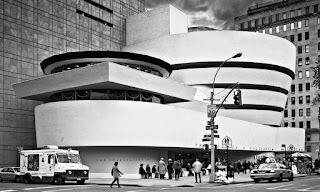 |
| ©Roland Halbe |
Construction has just been completed on the Perot Museum of Science in Dallas, Texas, designed by Thom Mayne of
Morphosis. It combines a number of previously separate museums into one new science museum. It's an interesting project for a number of reasons, but one aspect of it that i find intriguing can be seen in the image above, where the rational cube is seen sitting above an undulating plinth in the context of sprawl Dallas. There is a juxtaposition between the rational and irrational, which i find interesting in the context of Texas (where irrationality regarding science runs rampant, see Governor Perry's positions on global warming and teaching creationism), and which make an interesting comparison with the Guggenheim Museum in New York. The two can be seen as inverses of each other, with the Guggenheim assuming a rational perimeter for it's setting in the grid of New York, and the Perot choosing an irrational plinth for the sprawling ill definition of Dallas, so apparent in the image above. Both perimeters act as plinths of sorts, and both use opposing geometries to distinguish these plinths from the captured volumes that define the centers of these complexes. In both cases, one climbs to the top of the volume and then drop down to circulate through the exhibitions. The rational perimeter of the Guggenheim is contrasted with a somewhat irrational inverted cone (of sorts) down through which one circulates; the irrational perimeter of the Perot is contrasted with a rational cube, through which one moves in a different, bumpy kind of spiral.
 |
| ©Jonathan Savoie |
The undulating plinth of the Perot contains usual museum amenities such as cafe and bookstore, as well as an auditorium, things that can be seen as providing another kind of foundation for the museum itself, which resides in the cube. From a narrative standpoint, the plinth can be seen to be a landscape, or rather, our landscape, earth, and the cube can be taken to be our understanding of that in which we inhabit, science. In this context, it makes sense that the materiality of both are the same, and i'm glad the architects resisted making the cube another material from the plinth. Both are precast concrete, which is at once an organic material composed of the very earthy elements of sand and water, and a very "constructed", manmade material that must be mixed in very precise batches along with portland cement. That science is understood as having origins in "nature" is a nice way to articulate the idea that we don't exist apart from nature, but belong to it as all else, and are helped by our attempt to understand it on it's terms, rather than apart from it's terms, as does religion.
 |
Cube understood as having origins in plinth, as they share materiality and surface. This is the entry court.
©Iwan Baan |
The cube is not Villa Rotunda, supremacy sitting on a hill, overseeing our realm. It is a flawed, imperfect cube which seems to declare both our limitations and conflicts, as well as the perils of ignorance, which we are free to follow.
 |
| View of earthen landscape. ©Iwan Baan |
 |
| Note reluctance of plinth to engage with Dallas "context". ©Iwan Baan |
As can be seen in the images and section below, the underside of the cube can be seen as an extension of the surface of the plinth, such that the void of one assumes the materiality of the other; that they have an inverse relationship to each other that is at once both detached and engaged.
 |
| ©Iwan Baan |
 |
| ©Iwan Baan |
 |
| Ceiling appropriates surface of plinth. ©Morphosis |
 |
| The cube is a distressed one...©Morphosis |
 |
| Morphosis diagram. The cube floats in a sea of wonder, doesn't engage with city grid. |
 |
| Undulating plinth and context. @Arch Record |
Appropriately, this project looks like drought, as does much of Texas and the American midwest. As in much of Morphosis's work, there is little optimism in the jagged forms and eroded ideals of a once idealized geometry, and in our current political situation of science deniers holding the rest of us hostage, this project seems to be projecting a more foreboding future for us all.
















